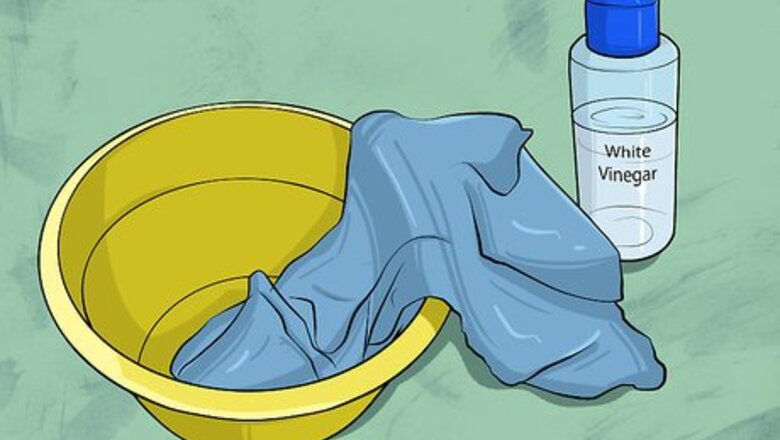
views
X
Research source
Mineral deposits and soap scum can build up on your marble, negatively impacting its appearance. Remove mild buildup and stains with a soft rag and white vinegar. Eliminate difficult stains with hydrogen peroxide or a special, heavy-duty cleaning solution. Ensure safe cleaning by avoiding harsh chemicals and abrasives.
Doing Daily Cleanup
Wet the surface of the countertop. Run a clean, damp cloth over the surface of the cultured marble to slightly wet it. This helps you avoid damaging the glaze that gives it its shine when you apply the soap or cleaner. If the surface already has lingering water, such as from a shower, you don't need to add more.
Apply a mild soap or all purpose cleaner to the surface. You can spray the soap or cleaner directly onto your cultured marble, or you can dampen a clean towel and wipe it over the surface. Choose a water-based cleaner with a neutral pH. It's the safest option for cleaning your cultured marble without damaging the glaze or scratching the surface.
Wipe the surface of the cultured marble with the rag. Make circular movements as you wipe away the soap or cleaner. If necessary, apply more soap or cleaner to the cultured marble. Continue wiping with your cloth until the surface is dry. Use a soft cloth to avoid scratching or damaging the surface. Don't use abrasive sponges or cloths. If your cloth is very wet, switch to a clean, dry cloth to remove the remaining cleanser.
Avoid using harsh chemicals, which can damage the surface. Harsh chemicals can damage the glaze on your cultured marble, making it appear dull. These cleaners can also cause chemical scuffs and scratches on your cultured marble. Stick to mild soaps and cleaners.
Removing Mild Buildup and Stains
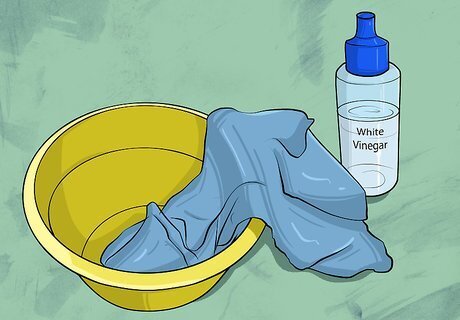
Dampen a clean rag with white vinegar. Your rag should be wet through with white vinegar, but excess vinegar should not drip or seep from the rag. Either pour vinegar onto your rag in a sink or dunk your rag in vinegar in a bucket. Wring out the rag lightly over a sink. Too much white vinegar can cause this liquid to spread to areas of the marble that are already clean. Although this can be wiped away easily, wringing out your rag after wetting it can prevent extra work. Vinegar is a great option for removing hard water stains or built up soap scum.

Drape the wet rag on top of stains or buildup. Place the vinegar dampened rag over the buildup or stain on your cultured marble. Make sure the rag is flat against the stain and the wet parts of the rag touch it. Allow the rag to remain on top of the buildup or stain for several hours. With especially light buildup or stains, you may be able to wipe these away in one swipe with your vinegar dampened rag.

Rinse the treated area with cold water. Remove the vinegar dampened rag from the afflicted area of your marble. Pour cold water from your sink into a cup or small bucket. Use this to douse the treated area of your marble. Wipe up excess liquid with a clean, soft, dry rag. Hot water in some cases can cause stains to stick to surfaces more stubbornly. Using cold water will prevent this from happening.
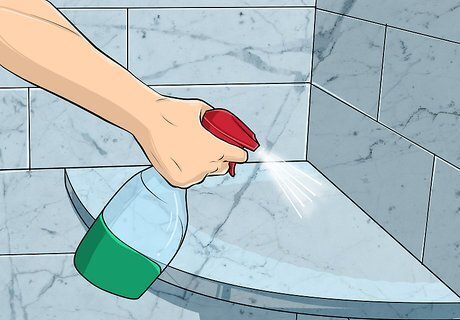
Treat remaining stains or buildup with a cleaning agent. Select a cleaning agent that is intended for marble or similar stone. This product should not have abrasives, which can scratch or compromise the finish of your marble. Follow the label directions on the product for best results. Although proper usage will vary from product to product, in many cases you can combine a product, like Barkeeper's Friend, with a small amount of water to make a paste. Apply this to remaining stains or buildup for a few hours. Generally, by allowing your cleaning product more time to work on the stain, the results will be better. However, this may not be the case with all cleaners. Be sure to check the label.
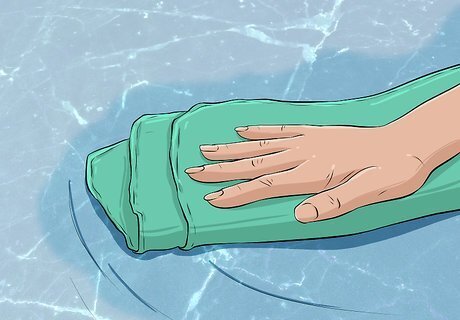
Rinse away the cleaning agent and polish the marble, if desired. Fill your cup with cold water again. Pour it on the cleaned portion of your marble and wipe up excess liquid and remaining dirtiness with a clean, soft, dry rag. After this, your counter should be clean. Polish the marble with a suitable polishing agent, such as countertop wax, and a soft rag or polishing cloth to restore its luster.
Eliminating Heavy Stains
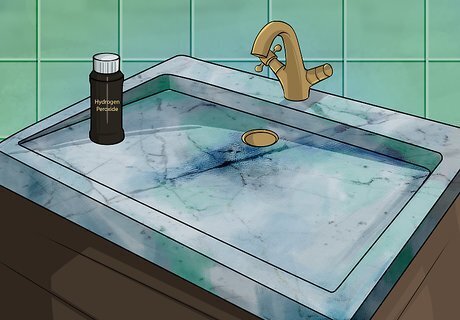
Treat dark colored stains with hydrogen peroxide. Soak a clean, soft rag with hydrogen peroxide. Wring excess peroxide out of the rag over your sink. Position the rag so its peroxide dampened parts directly touch and cover the stain. Keep the rag on the stain for several hours or overnight. Avoid using this technique if your marble is dark colored. Hydrogen peroxide on dark colors can lead to lightening. Less serious stains may only need 15 minutes to a half hour of time before the stain can be wiped away. Check less serious stains at regular intervals for this reason. If, at a glance, you can tell the stain you are working on will require heavy-duty techniques, you may want to skip the peroxide treatment and move straight to mixing a heavy-duty cleaning solution.

Rinse the treated area with cold water. Fill a cup or small bucket with cold water. Pour water onto the treated area of the marble. Use a clean, dry, soft cloth to wipe up standing water and any dirtiness. Heavy-duty stains may remain after cleaning the surface with peroxide, in which case you'll need to mix a heavy-duty cleaning solution.
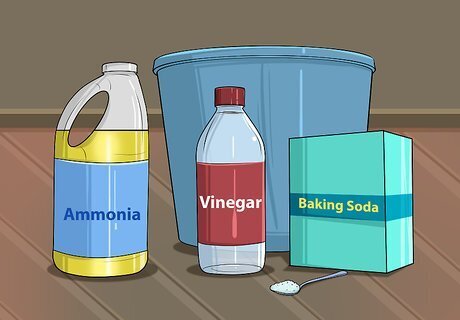
Mix a heavy-duty cleaning solution for remaining stains. In a medium sized bucket, combine ¼ cup (59 ml) baking soda, ¼ cup vinegar, ½ cup (118 ml) ammonia, and 8 cups (1.9 L) of hot water. Agitate the mixture with a kitchen implement, like a spoon, until the ingredients are consistently blended. The mixture will foam slightly. As an alternative to heavy-duty cleaners, you can use paint-thinner or denatured alcohol to remove the stain. However, always test these cleaners in an inconspicuous place on your cultured marble first, as they may damage the surface. Although this cleaning solution is made with household products, it can be harsh on your skin. Wear gloves when using this solution to prevent dry skin and irritation.
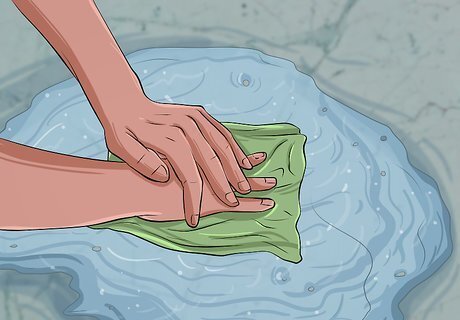
Apply the cleaning solution with a clean, soft rag. Douse your rag in the heavy-duty cleaning solution. Wring out excess solution over the sink, then lay the saturated rag on the stains. Wait roughly 10 minutes for the stain fighting action of the solution to go to work, then wipe away remaining liquid with a clean, dry, soft rag. Some stubborn stains might require a longer soak time. However, soaking your marble too long in this solution may be harmful to its finish.

Cleanse the area with water. Rinse the cleaned area with cold water in the same fashion as previously described. Wipe up water remaining on your marble and any dirtiness with a clean, dry, soft rag. Your cultured marble should now be clean.
Ensuring a Safe Cleaning
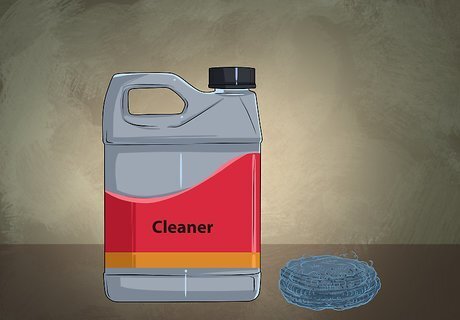
Avoid harsh cleaners and anything abrasive. Some cleaners may strip your marble of its finish. Check the label of all cleaners to ensure they are suitable for marble. Abrasives in cleaners and abrasive cleaning tools, like scouring pads, steel wool, or scrubbers, can also cause damage to the marble. The surfaces cleaners are intended for should be clearly marked on the label. Abrasives, too, are generally marked on the label.
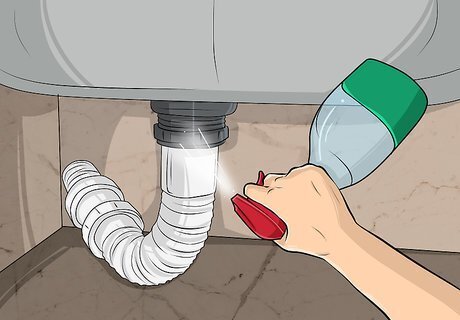
Test cleaning products on an out of view part of the marble. Even if the label says a cleaning product is suited for marble, it's always a good idea to test the cleaner first. Choose an out of sight location on the marble, like under a stationary appliance, and use a small amount of cleaner on the marble. If the finish or color is affected by the cleaner after it dries, refrain from using the cleaner.
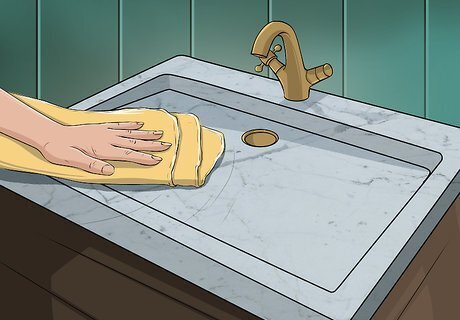
Soak stubborn stains in bleach. Although bleach is a generally accepted cleaning agent for marble, it's relatively harsh. Only use bleach sparingly to clean your marble. Same as when using vinegar or hydrogen peroxide, dampen a clean, soft rag with bleach, wring out excess, and drape the rag over stains. Only use this technique for marble that is light in color. Bleach may cause discoloration in dark colored pieces.

Identify engrained stains in your marble. If you've cleaned a spot time and again with various cleaners, it's likely the stain you are attempting to clean is engrained in the marble. To remove spots like this, the marble will have to be buffed and refinished. For the best results, this should only be attempted by a professional.


















Comments
0 comment